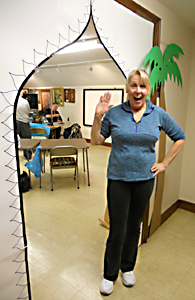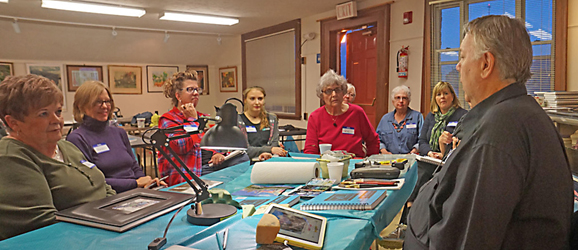 We
enjoyed another fantastic, amazing and successful weekend workshop
with artist, David Rankin, hosted by the Euclid Art Association.
It was a full class with artists attending from all over Northeast
Ohio, Columbus, Ohio, New Jersey, Michigan, Vermont and as far
away as Big Canoe, Georgia.
We
enjoyed another fantastic, amazing and successful weekend workshop
with artist, David Rankin, hosted by the Euclid Art Association.
It was a full class with artists attending from all over Northeast
Ohio, Columbus, Ohio, New Jersey, Michigan, Vermont and as far
away as Big Canoe, Georgia.
On Friday evening, as we entered the Gallery through our own ‘Taj
Palace’ gateway, we were transported to India. Indian music
played in the background. Some of David’s watercolors of
India were on display, along with three posters containing
pictures of India from a trip with David in 1989.
The smell of Indian Chai tea permeated the space. We all
enjoyed a cup of tea and Indian samosas compliments of David’s
beautiful wife, Deanna.
 All
this set the mood for our weekend workshop with David on How to
Develop a Sketchbook and Travel Journal.
All
this set the mood for our weekend workshop with David on How to
Develop a Sketchbook and Travel Journal.
David set the stage by telling us stories of his travels
throughout India since 1970. We sat there mesmerized.
He sketched all over India. Sketching has been an invaluable
skill for his entire career. His favorite sketchbook is the
blue XL Mix Media, 7” x 10”, 98 lb, by Canson. He likes it
because of the weight of the paper. “You can paint on it without
it buckling and getting nasty.” David suggested that we fill our
sketchbook pages with observations . . . be functional, don’t be
tedious . . . develop ideas quickly . . . and “you don’t have to
draw as well as I do!”
David gave us these additional tips for our sketchbook journal:
• Use a 2B pencil
or a black ball point pen. If you use a 9B graphite pencil,
it smudges in watercolor and bleeds through . . . same with a blue
pen.
• Work on the right side of the page.
• When sketching, look for SHAPES. This is key . . . it’s like
puzzle pieces.
• Draw what you see, focus on that, not what you think you see.
• Keep the pencil on the paper, make a definitive line, don’t be
tentative.
• Leave room on the page to add text . . . tell a story.
• Start in the upper left hand corner (if right handed) in your
sketchbook and fill the page with your observational studies.
Sketch in rectangular shapes, with or without a border.
Sometimes fill the whole page with one image or even sketch a full
two page spread. Remember that your sketches are ‘frameable’
and may even ‘sell’.
• The secret... “Stop, Look, Go”. This technique speeds up
your drawing. Decide what shape to start with. David
normally starts with the hair on the head or hat/turban.
Start sketching, stop but keep the pencil on the page,
look at the image and decide where to go next.
Our sketchbook tour of India begins....
The first sketch in our book is a map of India. It’s a good
idea to save the first page in your book for the ‘title’ page.
Next page, we are
on the plane flying from New York City over Greenland to London on
our way to New Delhi. We sketch Frank, and his sister Janet,
sleeping on the plane. Why? Because we can’t sleep. We
leave space at the top of the page for a map indicating where we
started and were we are going. We land in New Delhi . . .
our internal clock says we should go to bed, but we stay up.
It’s 8:30am in the morning here at the beautiful Imperial Hotel.
We have our breakfast out on the veranda. The next sketch in
our book is a breakfast of porridge with fresh strawberries and
bananas and a cup of latte. Looking out from the veranda we
see a bird in the grass. A bird we’ve never seen before.
It’s a Hoopoe. We quickly sketch it at the bottom of the
page. (As an aside.... in 1970 it only cost $28/day to stay
at the Imperial, now it’s about $400/day.)
Standing guard at the front door of the Imperial Hotel is Swaroop,
the doorman. We sketch Swaroop on a full page and later
paint him in color. David spends time showing us how to
sketch a face, especially the eyes. He also shows us how to
paint a flawless intense blue wash around the portrait of Swaroop.
Turn your sketchbook upside down, starting on the top right side,
get your bead started (use 2 1/2 inches of gravity), run it down
the page leaving a thin white edge next to the portrait (we’ll add
some spice colors there later, either orange or Winsor Green Blue
Shade). Then turn the book around and run the same bead down
the other side.
Next we sketch more faces using a black ball point pen . . .
Indian men with unique breads and turbans that we observe on our
travels. We fill the page with four images and, using Paynes
gray, we create beautiful small gray studies. David shows us
how to create value and depth in just three passes.
Our trip to India would not be complete without a ride on an
elephant, which we sketch next. Most of us were confused
about where to start. David had us start sketching ‘Joan’
sitting on top of the elephant, then ‘Raj, her boyfriend’, then
the blanket, then the elephant’s back and front legs, moving on to
it’s head, trunk and the mahout on top . . . don’t forget the
elephants tail and the bells hanging from the blanket.
“Remember, you are sketching shapes!”
Last, we sketch the
moonlight Taj, using David’s original watercolor as reference.
David admonishes us to keep the moon’s reflection in line directly
below the moon. Again using Payne's Gray, we paint
everything in the first pass with a light gray, except the moon
and it’s reflection which we leave white. After two
more passes of Payne's Gray, our little sketch looks pretty darn
good.
And with that our India tour comes to an end....but not before 16
of us enjoyed a delicious vegetarian Thali dinner at the Taj
Indian Palace located in the Hilltop Plaza in Richmond Heights.
A fun time was had by all! We thank both David and Deanna
for this absolutely amazing and fun weekend.